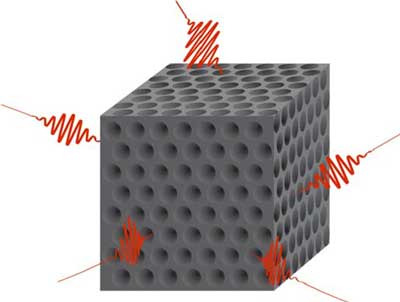
Just as there is no such thing as a complete vacuum, there is no such thing as complete darkness. This is because there are always continuous fluctuations of light in space, also known as light noise. Theory predicts that this light noise might be completely eliminated in photonic crystals, however, so allowing them to become absolutely dark.
Photonic crystals are nanostructured materials in which a periodic variation of the refractive index on the length scale of visible light produces a photonic “band gap”. This gap affects how photons propagate through the material and is similar to the way in which a periodic potential in semiconductors affects the flow of electrons by defining allowed and forbidden energy bands. In the case of photonic crystals, light of certain wavelength ranges can pass through the photonic band gap while light in other ranges is reflected.
Finite not infinite
For a photonic crystal to possess the extraordinary property of absolute darkness, theory has it, however, that its periodic structure must repeat indefinitely throughout the entire universe, explains team leader Willem Vos of the MESA+ Institute for Nanotechnology in Twente. But, real nanostructures are of course finite so we need to ask ourselves the question: how fast does the density of states in the band gap of a finite-sized crystal approach the infinite-crystal limit – that is, how fast can complete darkness be reached by making nanostructures larger and larger?
To answer this question, the researchers developed a new theory that describes how light noise is suppressed as a function of the crystal size. They began with a simplistic model that describes a photonic bandgap crystal. To introduce the effect of a finite support, they then considered a sphere made up of such a material and surrounded by vacuum. This vacuum interface serves to introduce optical states, they explain.
“We can analytically solve the local density of states in such a geometry and we use it to calculate the density of states inside the sphere,” they say.
Linear not exponential
“Until now, it was thought that light noise at one position inside a real finite crystal approaches the infinite size limit in an exponential way,” says Vos. “With our new calculations, we found that the density of light noise is in fact inversely proportional to the length of the crystal (as the number of unit cells in the crystal increases).” This process is much slower than the theoretically predicted exponential decrease in light noise.
This “straight path to absolute darkness”, as the researchers have dubbed it, applies not only to 3D nanostructures but also to periodic arrays of nanorods or nanoholes in a 2D slab and even periodic stacks of layers in 1D. “This discovery could help photonic engineers to design nanostructures of the right size as a function of the end-functionality required,” says co-team leader Ad Lagendijk who presented the work this week in a keynote talk at the EOS Meeting on Waves in Complex Photonic Media in Capri, Italy. Such nanostructures include on-chip miniature lasers, light emitting diodes or photovoltaic cells.
“Photonic crystals can be used to manipulate photonic density of states, which is potentially important for many applications,” comments Marin Soljacic of the Massachusetts Institute of Technology, who was not involved in this work. “This study calculates this effect explicitly and quantitatively, however, in realistic (finite size) systems like those that would actually be used in applications. The new results are thus useful to people trying to use photonic crystals in these applications.”
Vos and colleagues say they are collaborating with scientists from ASML, the world’s leading lithography company, and Philips Lighting and Lumileds. Their research is detailed in Phys. Rev. Lett. 120 237402. A preprint is available here.



